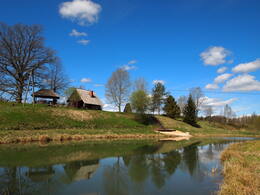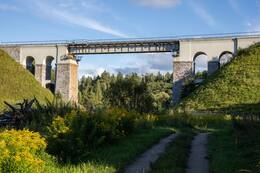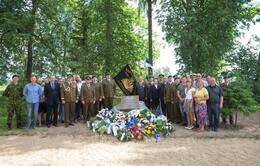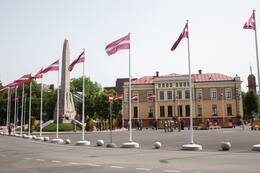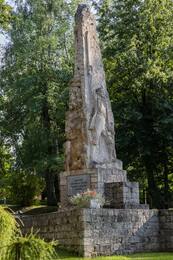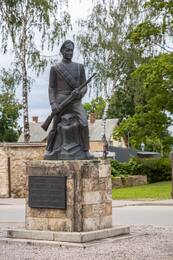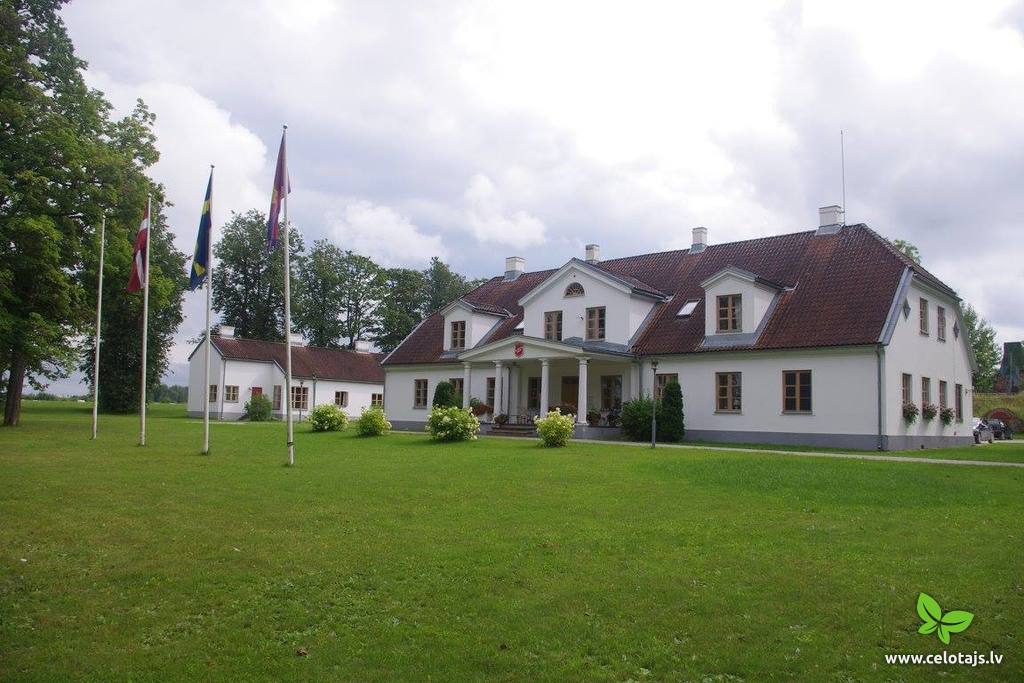In the footsteps of the Battles of Cēsis
Day 1.
153 km
Rīga – Amata – Skangaļi – Cēsis
Practical info
- Driving distance: 153 km
- Guided excursions and picnics in “Forest battles” by advance booking only
- The railway bridge over the Rauna River is best viewed from the right side of the Cēsis–Valmiera highway. It can only be viewed from a distance
Sights
Recreation Place “Meža kaujas”, the Main Venues of the Cēsis Battles near the Amata Bridge
Named Forest Battles, the rest area is situated in the main location of the Battles of Cēsis near the Amata bridge. Visitors can listen to stories about the Battles of Cēsis and can take part in various activities, including hikes and trips around the most important venues of the Battles of Cēsis, and team battles. At the end, the visitors can enjoy an invigorating wartime soup. The railway bridge over Amata played a very important role throughout the War of Independence, as the first clashes of the Estonian Army with the Landeswehr took place here. On 5 June 1919, the first battle of the Estonian Army’s armoured trains with the Baltic Landeswehr units took place by the railway bridge over Amata. The Landeswehr, knowing that an armoured train was approaching, planted mines on the railway bridge and secured positions at the homestead Amatas on the riverbank in preparation for a possible battle. The bridge over Amata marked the border between Estonian forces and the Germans. On the night of 23 June 1919, during the Battles of Cēsis, the Landeswehr left Cēsis and retreated to the Amata river line. When retreating, the Germans burned down the Cēsis Latvian Society House and blew up the bridge over Amata.
A unique opportunity is offered to watch the events of June 5, 1919 through virtual reality glasses.
The railway bridge over the river Rauna
The railway bridge over the River Rauna is located near the P20 highway, in Priekuļi parish. It can be viewed from the right side of the Cēsis-Valmiera highway. The railway bridge is not intended for pedestrians and is watched over by security guards. Built in 1889, the masonry bridge on the Riga-Valka railway line is the highest railway structure of its kind in the Baltics. It is 24 metres high and 78.9 metres long. Trains, especially heavy freight trains, must maintain a speed of 80 km/h. Higher speeds are not allowed on the bridge. However, at lower speeds, the train is unable to deal with the slight incline on both sides of the bridge and may start to slide backwards. In June 1919, during the Estonian and Latvian Wars of Independence, reinforcements to the Estonian Army, which also included the Northern Latvian Brigade, were sent by rail across the bridge from Valka, which was at the back of the front. When the 2nd Cēsis Infantry Regiment was forced to retreat from Cēsis, its units strengthened their positions on the banks of the River Rauna. The railway bridge became part of the fortification and ensured the movement of Estonian armoured trains during the battles. During World War II, on 4 July 1941, the bridge was blown up by the fleeing Red Army when the Soviet occupation of Latvia was replaced by the German occupation. German Army sappers restored the bridge within a week. After World War II, during the Soviet occupation, the bridge over Rauna was of military strategic importance and was heavily guarded.
Memorial at Skangaļi Manor
The memorial to the victory of the combined Latvian and Estonian troops in the battle for the Skangaļi Manor is located about 20 kilometres from Cēsis. Devoted to the participants of the Battles of Cēsis and the fighters of the Estonian Kalevlaste Maleva Battalion, the memorial stone was unveiled on 22 June 2019. The victory of the combined Latvian and Estonian troops in the battle for the Skangaļi Manor, which took place here, was a turning point in the Battles of Cēsis, as a result of which the troops of Niedra’s government initiated a general retreat. The government of Andrievs Niedra was a provisional pro-German government of Latvia, which existed from 10 May to 26 June 1919. The attack on the Landeswehr unit began in the early morning of 22 June 1919 when the 3rd Kalev company used an armoured train to break into the Skangaļi Manor where they seized 2 cannons, however, the enemy still went on a counterattack. The troops repeated the attack slightly later, in the middle of the day, and the Landeswehr unit was forced out of the Skangaļi Manor following fierce close combat. The trophies from the battle include machine guns, large quantities of ammunition and other combat equipment. Two hours later, the Estonians captured an important road junction at the Starti pub. 58 Kalev soldiers were injured or lost their lives in the battle to capture the Skangaļi Manor. Estonia provided significant support in establishing the memorial site.
Victory monument in Cēsis
The Victory Monument to Latvians and Estonians killed in the Battles of Cēsis is located in the city of Cēsis, on Vienības Square. In honour of the participants of the 1919 Battles of Cēsis, on 22 June 1924, the first stone was laid for the Victory Monument as sketched by architect Pauls Kundziņš, using funds donated by the people. During the Soviet occupation regime, on the night of 25 March 1951, the monument was blown up and taken down completely. A monument to Lenin, created by sculptor Kārlis Jansons, stood on the former Victory (Unity) Square from 1959 to 1990. In 1997, Māris Niklass, chairperson of the Cēsis District Council, managed to involve Estonian state institutions in the restoration of the monument. The material needed for the construction of the monument, Saaremaa dolomite, was received from Estonia as a gift. On 22 June 1998, during the celebrations of the 79th anniversary of the Battles of Cēsis, the first stone of the monument to be restored was laid on Vienības Square. A ceremony to unveil the restored Victory Monument took place in Cēsis on 15 November 1998 (author: architect Imants Timermanis). Information about the Victory Monument is available in the ‘Cēsis and the Latvian War of Independence’ exhibit of the Cēsis History and Art Museum, in the New Castle.
Monument commemorating the Cēsis battles
The monument to the Estonian and Latvian soldiers who died in the Battles of Cēsis is located in Priekuļi municipality, Liepā, about 1 kilometre south of the Lode Railway Station, on the side of Rūpnīcas street. The first stone of the monument was laid on 22 September 1929, and the monument was unveiled on 11 August 1935. Based on a sketch by Sculptor Augusts Julla who lived in Jullas, Liepa parish, and made of limestone from the village of Allaži, the monument is a high-relief depiction of a peasant soldier leaning on a plough with one hand and a raised sword in the other. The death mask of the sculptor’s father Jānis Julla was used to create the face of the sculpture. According to Aivars Vilnis, a researcher of the history of Liepa parish, a bird’s eye view of the monument reveals that the base of and the path and stairs leading to the monument form the shape of an arrow facing Liepa Manor (Lindenhoff) in the direction of German positions during the Battles of Cēsis. There is doubt, of course, as to whether this was truly the author’s intention at the time; however, it certainly enriches our interpretation of the monument today. Next to the monument are the only natural sandstone arches in Latvia known as ‘Lielā Ellīte’ (‘Liepas Ellīte’ or the Devil’s Kiln).
Monument for students of the Cēsis Regiment
The monument to the soldiers of the Cēsis Regiment Students’ Company who died in the Battles of Cēsis is located in the city of Cēsis, near the intersection of Palasta and Bērzaines streets. The construction of the monument was proposed by the Soldiers’ Association of the Cēsis Regiment Students’ Company. The monument was unveiled on 26 May 1938. The monument is based on the idea sketched by artist Jānis Rozenbergs, a former soldier of the company. Placed on a metre-high limestone pedestal, the 1.8-metre copper sculpture of a soldier dressed in a school student’s uniform was created by sculptor Rūdolfs Āboltiņš and coppersmith Jānis Zibens. An owl, a symbol of wisdom and knowledge, lies at the soldier’s feet, squatting on and protecting the books of a student who went to war. The sculpture was demolished during the Soviet re-occupation in 1952. A monument named the Komsomol Flag Bearer by sculptor Kārlis Jansons was erected near its former location in 1957. Placed near its historic site, the restored monument was unveiled on 11 November 1992. At the same time, in 1992, a monument to the Komsomol, which had been erected by the occupation regime, was taken down.
Virtual reality binoculars "Battles of Cēsis"
The Battle of Cēsis was one of the most significant turning points in the course of the Latvian War of Independence (1918 - 1920). On June 5, 1919, with a clash between armored trains of the Estonian Army and Landeswehr units near the Ieriķi railway station at the bridge over the Amata, the first stage of the Battle of Cēsis began. In commemoration of this event, a tourist attraction has been created near the Ieriķi station, which offers to experience the story of history using the possibilities of modern technology - with the help of virtual reality. The five-minute video “BATTLE AT THE BRIDGE OVER THE AMATA” can be viewed for free every day in virtual reality binoculars. Video duration: 5 min., LV with subtitles LV, ENG, EST and ES.
Places to eat
“Āraiši Windmill” country kitchen near Cēsis
The Lake Castle of Āraiši is of pan-European importance. It is a reconstructed Lettigalian lake castle from the 9th or 10th century, and it is the only place in the Baltic States at which visitors can learn about how people lived more than 1,000 years ago. The castle offers various thematic events.
In Cēsis turisms.cesis.lv/en/where-to-eat/
Places to stay
Skangaļi manor near Rauna
The manor is located in a quiet and peaceful center of Vidzeme, Priekuli district, between Cesis and Valmiera. In the main building of the manor there is a guest house, which has a kitchen with a dining room, lounge, guest bedrooms and a conference hall. A sauna can be be booked on request. There is a pond, a fireplace and a barbecue.
In the cozy dining room of the manor you can enjoy a meal prepared by skilled chefs. Guests will find refrigerator, kettle, microwave, toaster available. We offer home-grown seasonal vegetables, fruits and berries.
There is an exposition in the former barn building of Skangaļi manor, where you will learn about the history, present and future plans of the manor in the guide's story and during the tour of the manor complex. In the season / May-October / opportunity to see an exhibition of works of art.
Camping “Apaļkalns” near Cēsis
By the lake Raiskums, 9km from Cēsis. 3 well equipped cottages for 2 to 4 guests. 3 modest 4-bed cabins. Kitchen, washing and WC facilities in service building. Floored tenting and caravan sites with power connection, table and benches, a grill. Children playground.
In Cēsis turisms.cesis.lv/en/where-to-stay/




